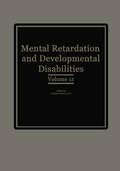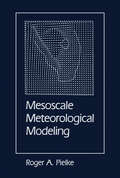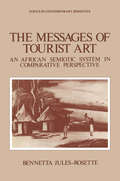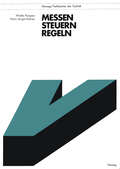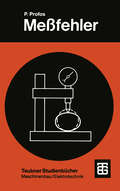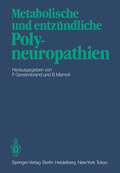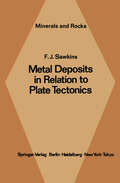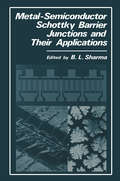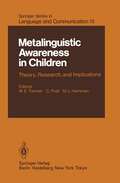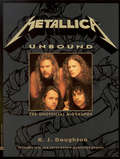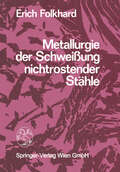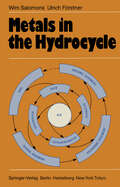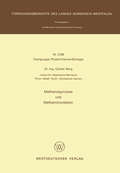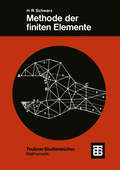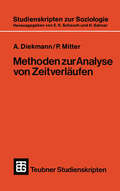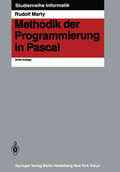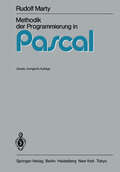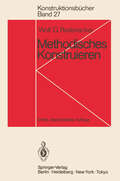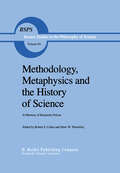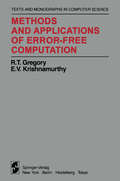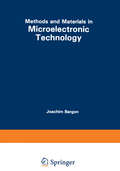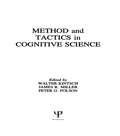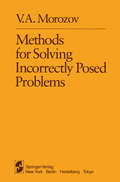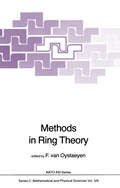- Table View
- List View
Mesoscale Meteorological Modeling
by Roger A. Pielke Sr.To effectively utilize mesoscale dynamical simulations of the atmosphere, it is necessary to have an understanding the basic physical and mathematical foundations of the models and to have an appreciation of how a particular atmospheric system works. Mesoscale Meteorological Modeling provides such an overview of mesoscale numerical modeling. Starting with fundamental concepts, this text can be used to evaluate the scientific basis of any simulation model that has been or will be developed. Basic material is provided for the beginner as well as more in-depth treatment for the specialist. This text is useful to both the practitioner and the researcher of the mesoscale phenomena.
The Messages of Tourist Art: An African Semiotic System in Comparative Perspective (Topics in Contemporary Semiotics #4)
by Bennetta Jules-RosetteTourist art may be a billion dollar business. Nevertheless, such art is despised. What is worse, the "bad" culture is seen as driving out the "good. " Commer cialization is assumed to destroy traditional arts and crafts, replacing them with junk. The process is seen as demeaning to artists in the traditional societies, who are seduced into a type of whoredom: unfeeling production of false beauty for money. The arts remain problematic for the social sciences. Sociology textbooks treat the arts as subordinate reflections of social forces, norms, or groups. An thropology textbooks conventionally isolate the arts in a separate chapter, failing to integrate them with analyses of kinship, economics, politics, language, or biology. Textbooks reflect the guiding theories, which emphasize such factors as modes of production, patterns of thought, or biological and normative con straints, but their authors have not adequately formulated the aesthetic dimen sion. One may compare the theoretical status of the arts to that of religion. After the contributions by Emile Durkheim and Max Weber, the sociology of religion is well established, but where is a Durkheim or Weber for the sociology of art? What is true of the social sciences in general holds for understanding of modernization in the Third World. These processes and those places are analyzed economically, politically, and socially, but the aesthetic dimension is treated in isolation, if at all, and is poorly grasped in relation to the other forces.
Metal Deposits in Relation to Plate Tectonics (Minerals, Rocks and Mountains #17)
by F. J. SawkinsI attempt this volume with no small degree of trepidation, for despite the near universal acceptance of plate tectonic theory, and the undeniable sweep and power of the concepts in volved, points of controversy and uncertainty still abound. This is especially true with regard to the limited extent to which many ancient geologic terrains, however well studied, lend themselves to plate tectonic interpretation. There is also considerable controversy regarding the genesis of many metal deposits, and this impacts upon the degree to which such deposits can be meaningfully related to the tectonic settings in which they occur. It is relatively simple matter to point out that certain types of ore deposits exhibit impressive time-space associations with certain kinds of more recent plate boundary environ ments. It is also all too easy to possible plate tectonic-ore deposit relationships in ancient geologic terrains. What is more challenging is the recognition of the boundaries beyond which speculation is idle, but within which useful new insights regarding the relationship of certain ores to their lithologic and tectonic environments may emerge.
Metal-Semiconductor Schottky Barrier Junctions and Their Applications
by B. L. SharmaThe present-day semiconductor technology would be inconceivable without extensive use of Schottky barrier junctions. In spite of an excellent book by Professor E.H. Rhoderick (1978) dealing with the basic principles of metal semiconductor contacts and a few recent review articles, the need for a monograph on "Metal-Semiconductor Schottky Barrier Junctions and Their Applications" has long been felt by students, researchers, and technologists. It was in this context that the idea of publishing such a monograph by Mr. Ellis H. Rosenberg, Senior Editor, Plenum Publishing Corporation, was considered very timely. Due to the numerous and varied applications of Schottky barrier junctions, the task of bringing it out, however, looked difficult in the beginning. After discussions at various levels, it was deemed appropriate to include only those typical applications which were extremely rich in R&D and still posed many challenges so that it could be brought out in the stipulated time frame. Keeping in view the larger interest, it was also considered necessary to have the different topics of Schottky barrier junctions written by experts.
Metalinguistic Awareness in Children: Theory, Research, and Implications (Springer Series in Language and Communication #15)
by J. Bowey R. Grieve M. Herriman M. Myhill A. Nesdale C. Pratt W.E. TunmerIn the past fi fteen years there has been a growi ng interest in the development of children's awareness of language as an object in itself -- a phenomenon now generally referred to as metal inguistic awareness. Until the publication of an earlier volume in the Springer Series in Language and Communication, The Chitd's Conoeption oi Language, edited by A. Sinclair, R. J. Jarvella, and W. J. M. Levelt, there had been no systematic treatment of metalinguistic awareness. The major goal of that volume was to map out the field of study by describing the phenomenon of interest and defining major theoretical issues. The aim of the present volume is to present an overview of metalinguistic awareness in children which reflects the current state of research and theory. The volume is divided into three major sections. The first considers various conceptual and methodological issues that have arisen from efforts to study metalinguistic awareness. It addresses such questions as what is metalinguistic awareness, when does it begin to emerge, and what tasks and procedures can be employed to assess its development in young children. The second sect ion cri ti ca 11y revi ews the research that has been conducted i nto the four general types of metalinguistic awareness -- phonologieal, word, syntactic, and pragmatic awareness. In the final section the development of metalinguistic awareness is examined in relation to general cognitive development, reading acquisition, bilingualism, and early childhood education.
Metallica Unbound
by K.J. DoughtonWritten by a noted hard rock journalist who has covered the band since its inception 10 years ago, this one-of-a-kind, full-color collectors' volume provides the most in-depth information on the band available anywhere. Rare and never-before-published photos. Complete discography.
Methanolpyrolyse und Methanoloxidation (Forschungsberichte des Landes Nordrhein-Westfalen #3189)
by Günter BergMethode der finiten Elemente: Eine Einführung unter besonderer Berücksichtigung der Rechenpraxis (Teubner Studienbücher Mathematik)
by Hans Rudolf SchwarzMethoden zur Analyse von Zeitverläufen: Anwendungen stochastischer Prozesse bei der Untersuchung von Ereignisdaten (Teubner Studienskripten zur Soziologie #122)
by P. MitterMethodisches Konstruieren: Grundlagen, Methodik, praktische Beispiele (Konstruktionsbücher #27)
by Wolf G. RodenackerMethodology, Metaphysics and the History of Science: In Memory of Benjamin Nelson (Boston Studies in the Philosophy and History of Science #84)
by Robert S. Cohen and Marx W. WartofskyThis selection of papers that were presented (or nearly so!) to the Boston Colloquium for the Philosophy of Science during the seventies fairly re presents some of the most disturbing issues of scientific knowledge in these years. To the distant observer, it may seem that the defense of rational standards, objective reference, methodical self-correction, even the distin guishing of the foolish from the sensible and the truth-seeking from the ideological, has nearly collapsed. In fact, the defense may be seen to have shifted; the knowledge business came under scrutiny decades ago and, indeed, from the time of Francis Bacon and even far earlier, the practicality of the discovery of knowledge was either hailed or lamented. So the defense may be founded on the premise that science may yet be liberating. In that case, the analysis of philosophical issues expands to embrace issues of social interest and social function, of instrumentality and arbitrary perspective, of biological constraints (upon knowledge as well as upon the species-wide behavior of human beings in other relationships too), of distortions due to explanatory metaphors and imposed categories, and of radical comparisons among the perspectives of different civilizations. Some of our contributors are frankly programmatic, showing how problems must be formulated afresh, how evasions must be identified and omissions rectified, but they do not reach their own completion.
Methods and Applications of Error-Free Computation (Monographs in Computer Science)
by R. T. Gregory E. V. KrishnamurthyThis book is written as an introduction to the theory of error-free computation. In addition, we include several chapters that illustrate how error-free com putation can be applied in practice. The book is intended for seniors and first year graduate students in fields of study involving scientific computation using digital computers, and for researchers (in those same fields) who wish to obtain an introduction to the subject. We are motivated by the fact that there are large classes of ill-conditioned problems, and there are numerically unstable algorithms, and in either or both of these situations we cannot tolerate rounding errors during the numerical computations involved in obtaining solutions to the problems. Thus, it is important to study finite number systems for digital computers which have the property that computation can be performed free of rounding errors. In Chapter I we discuss single-modulus and multiple-modulus residue number systems and arithmetic in these systems, where the operands may be either integers or rational numbers. In Chapter II we discuss finite-segment p-adic number systems and their relationship to the p-adic numbers of Hensel [1908]. Each rational number in a certain finite set is assigned a unique Hensel code and arithmetic operations using Hensel codes as operands is mathe matically equivalent to those same arithmetic operations using the cor responding rational numbers as operands. Finite-segment p-adic arithmetic shares with residue arithmetic the property that it is free of rounding errors.
Methods and Materials in Microelectronic Technology (The IBM Research Symposia Series)
by Joachim BargonThe papers collected in this volume were presented at the International Symposium on Methods and Materials in Microelectronic Technology. This symposium was sponsored by IBM Germany, and it was held September 29 - October 1, 1982, in Bad Neuenahr, West Germany. The progress of semiconductor and microelectronic technology has become so rapid and the field so sophisticated that it is imperative to exchange the latest insight gained as frequently as it can be accomplished. In addition, it is peculiar for this field that the bulk of the investigations are carried out at industrial research and development laboratories, which makes some of the results less readily accessible. Because of these circumstances, the academic community, which among other things, is supposed to communicate the prog ress in this field to students of different disciplines, finds it rather difficult to stay properly informed. It was the intent of this IBM sponsored symposium to bring together key scientists from academic institutions, primarily from Europe, with principal investigators of the industrial scene. Accordingly, this symposium exposed technologists to scientists and vice versa. Scientific advances often lead directly to technological innovations. In turn, new technologies are often arrived at empirically and, because of that, are initially poorly understood. Scientific inquiry then attempts to probe these processes and phenomena in order to achieve a better understanding. Thus science and technology are intricately interconnected, and it is important that technical exchange between technolo gists and scientists is facilitated, since the problems are typically interdiscipli nary in nature.
Methods and Tactics in Cognitive Science
by WALTER KINTSCH, JAMES R. MILLER AND PETER G. POLSONFirst published in 1984. Routledge is an imprint of Taylor & Francis, an informa company.
Methods and Tactics in Cognitive Science
by W. Kintsch J. R. Miller P. G. PolsonFirst published in 1984. Routledge is an imprint of Taylor & Francis, an informa company.
Methods for Solving Incorrectly Posed Problems
by V.A. MorozovSome problems of mathematical physics and analysis can be formulated as the problem of solving the equation f € F, (1) Au = f, where A: DA C U + F is an operator with a non-empty domain of definition D , in a metric space U, with range in a metric space F. The metrics A on U and F will be denoted by P and P ' respectively. Relative u F to the twin spaces U and F, J. Hadamard P-06] gave the following defini tion of correctness: the problem (1) is said to be well-posed (correct, properly posed) if the following conditions are satisfied: (1) The range of the value Q of the operator A coincides with A F ("sol vabi li ty" condition); (2) The equality AU = AU for any u ,u € DA implies the I 2 l 2 equality u = u ("uniqueness" condition); l 2 (3) The inverse operator A-I is continuous on F ("stability" condition). Any reasonable mathematical formulation of a physical problem requires that conditions (1)-(3) be satisfied. That is why Hadamard postulated that any "ill-posed" (improperly posed) problem, that is to say, one which does not satisfy conditions (1)-(3), is non-physical. Hadamard also gave the now classical example of an ill-posed problem, namely, the Cauchy problem for the Laplace equation.
Methods in Ring Theory (Nato Science Series C: #129)
by Freddy Van OystaeyenProceedings of the NATO Advanced Study Institute, Antwerp, Belgium, August 2-12, 1983
